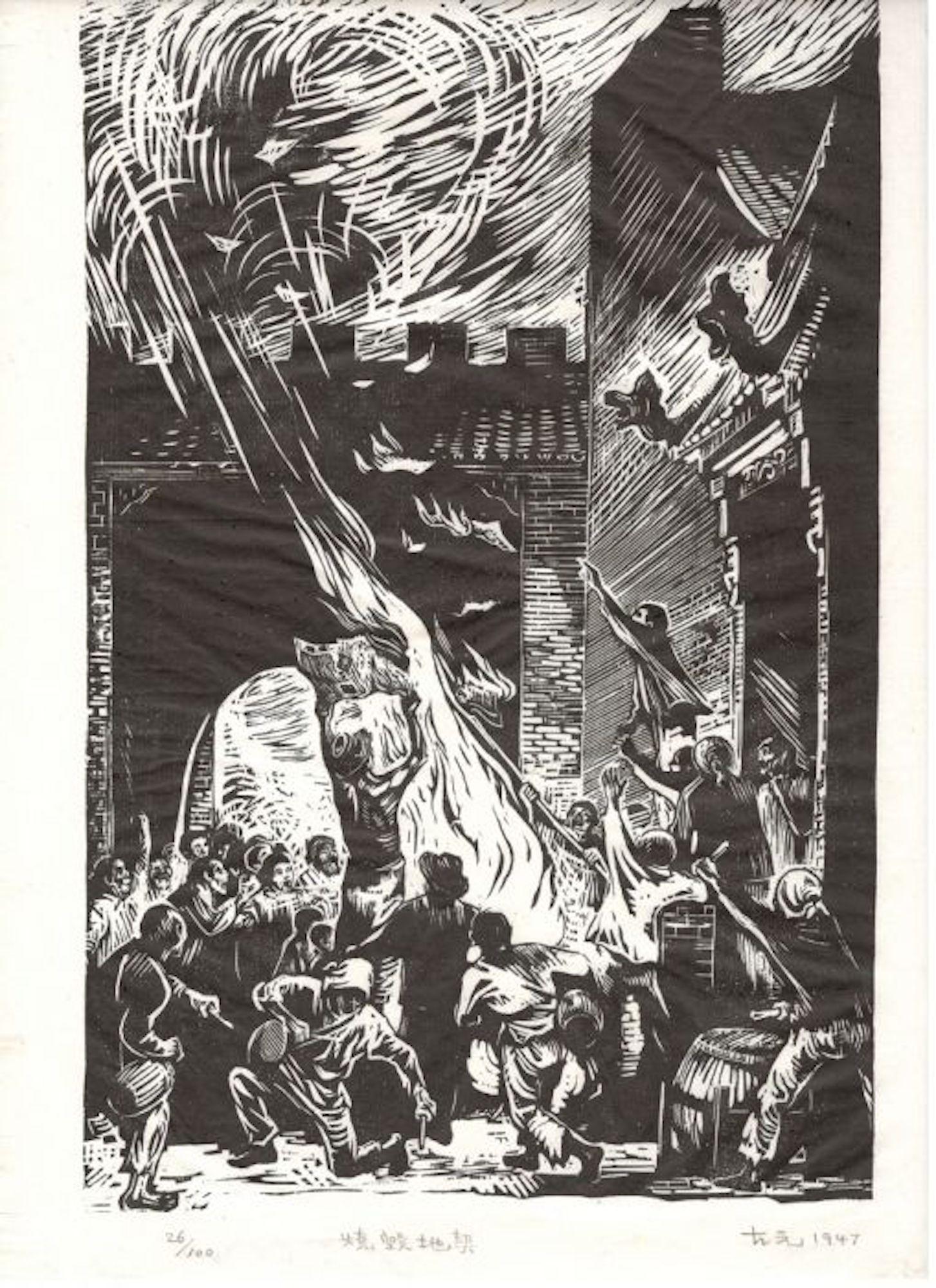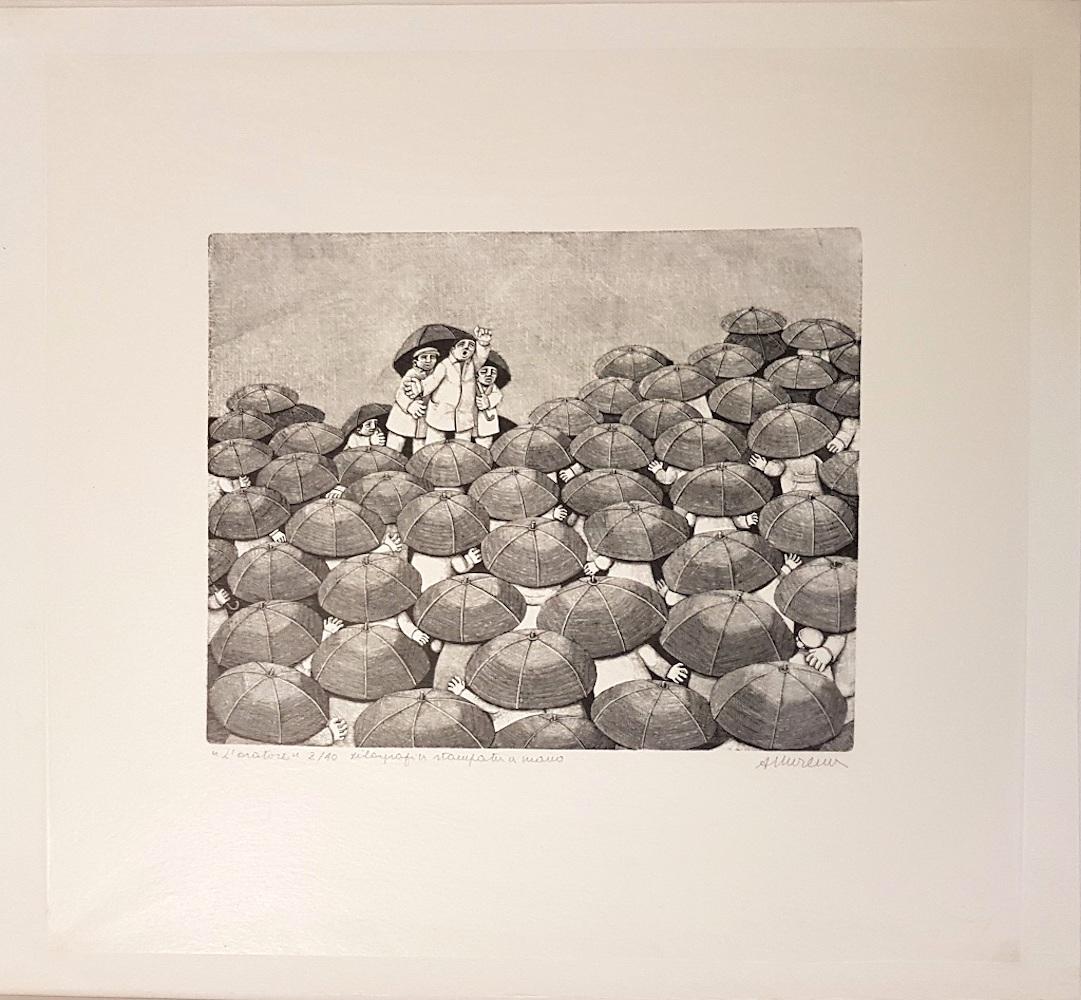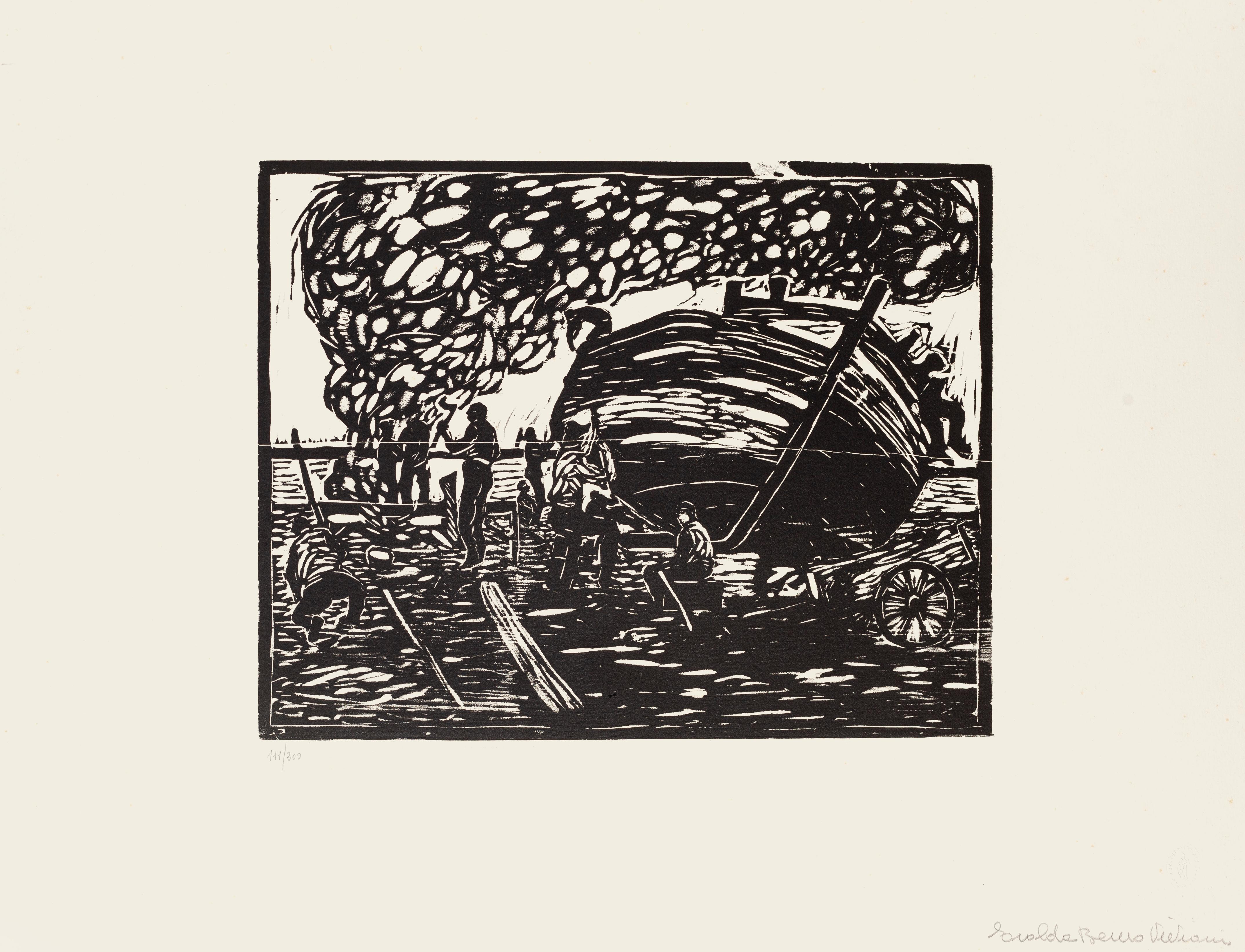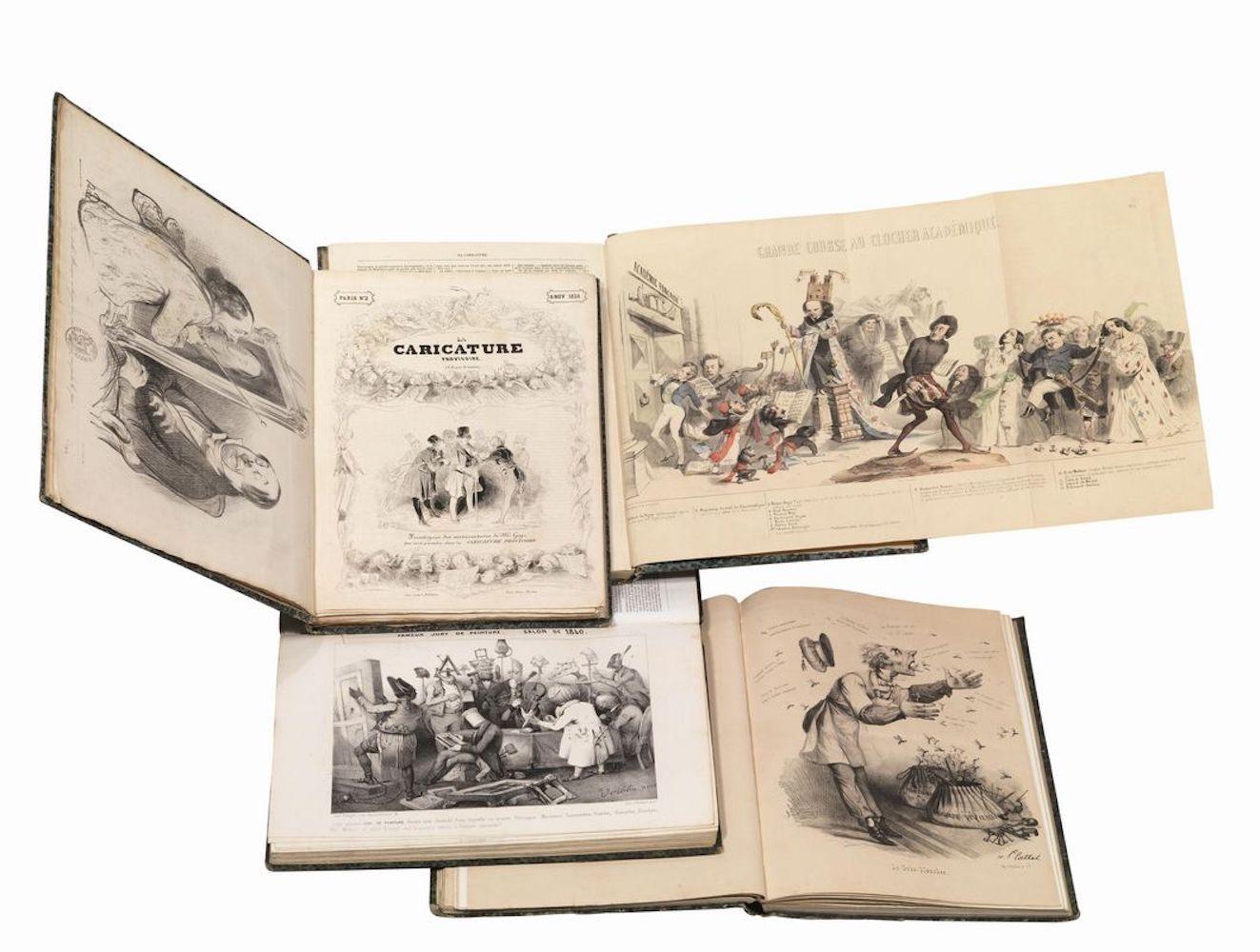Items Similar to Inari Kozo Tasaburo- Kabuki
Want more images or videos?
Request additional images or videos from the seller
1 of 11
Utagawa ToyokuniInari Kozo Tasaburo- Kabuki1820
1820
About the Item
Inari Kozo Tasaburo- Kabuki
Color woodcut, c. 1820
Signed: ‘Toyokuni’
Publisher: ‘Yamamoto Heikichi’
Censor: Hama and Magome
Very good impression and color
Sheet/Image size: 15 1/2 x 10 5/8 inches
Note: Kabuki actor Ichikawa Monnosuke is in the role of Inari Kozo Tasaburo. He swam the river and is wringing his clothes at the riverbank. A scene from the play “Edo no Hana Mukashi Nishiki E” performed at Kawarazaki theater.
Utagawa Toyokuni I (1769-1825)
Toyokuni Utagawa was one of the great printmakers of the late 18th century who made himself known by his ukiyo-e of beautiful women and later of actors. As the head of the Utagawa school he was also the most influential man on the next generation of ukiyo-e designers.
Toyokuni was born the son of a puppet maker. He learned printmaking as a student of Toyoharu. At the beginning of his career he concentrated on bijin-ga - images of beautiful women. His early works were influenced by Kiyonaga and Shigemasa.
Toyokuni's success and fame came when he started making actor portraits and actor scenes. The Kabuki theaters were very crowded at that time and the best known actors were a kind of public icons. Consequently prints related to Kabuki were a hot business. Demand came from the theaters - for advertising material - and from the fans - in the form of actor portraits. The production of actor portraits was like today's publication of celebrity posters.
When the demand for actor prints grew faster than the master could design, the great moment of the Utagawa School had come. An ever increasing number of students produced actor prints and book illustrations. The Utagawa School was buzzing with commissions.
The Utagawa School flourished so well that Toyokuni Utagawa is sometimes mentioned as the founder of the Utagawa School, but that was actually Toyoharu. Toyokuni, however, was the one who made it big and who went into mass production. The comparison may be a bit daring. But basically the Utagawa School was something like the Andy Warhol factory of the Pop Art culture - at least in commercial terms.
The best known ukiyo-e students of the master Toyokuni Utagawa were Kunisada Utagawa and Kuniyoshi Utagawa. The tombstone of Toyokuni listed altogether 29 students.
After the death of Toyokuni in 1825, two of his pupils rivaled about who had the right to become his successor - the conceited Kunisada, who considered himself the greatest on earth anyway, and Toyoshige, a mediocre printmaker who had the advantage of having married his deceased master's daughter. The row about the succession to Toyokuni as the head of the Utagawa School was fought on arguments over who was the best ukiyo-e designer. But that was an argument on the surface. The real fight was about who got control of a flourishing business company - the Utagawa School.
Toyoshige won the fight but died in 1835. From 1844 on Kunisada called himself Toyokuni. In today's literature Kunisada is referred to as Toyokuni III, Toyoshige as Toyokuni II and the master as Toyokuni I.
Courtesy, Artelino Literature sources used for this biography:
• Richard Lane, Images from the Floating World (New York: Konecky & Konecky, 1978)
• Laurance P.Roberts, A Dictionary of Japanese Artists (New York: John Weatherhill Inc., 1976)
- Creator:Utagawa Toyokuni (1769 - 1825)
- Creation Year:1820
- Dimensions:Height: 15.5 in (39.37 cm)Width: 10.63 in (27.01 cm)
- Medium:
- Period:
- Condition:
- Gallery Location:Fairlawn, OH
- Reference Number:
About the Seller
5.0
Recognized Seller
These prestigious sellers are industry leaders and represent the highest echelon for item quality and design.
Platinum Seller
These expertly vetted sellers are 1stDibs' most experienced sellers and are rated highest by our customers.
Established in 1978
1stDibs seller since 2013
712 sales on 1stDibs
Typical response time: 1 hour
Associations
International Fine Print Dealers Association
- ShippingRetrieving quote...Ships From: Akron, OH
- Return PolicyA return for this item may be initiated within 10 days of delivery.
More From This SellerView All
- Xylon 21 Naoko Matsubara USALocated in Fairlawn, OHXylon 21 Naoko Matsubara USA Woodcuts, two which are printed in color, 1970 2 of the 5 woodcuts signed in pencil (see photos) Five original woodcuts, two of which are signed in pencil With introduction entitled Honest Pinetree by Frizt Eichenberg The images are: The Quaker’s Meeting, double page woodcut cover on grey/green paper, signed in pencil, with usual centerfold Publisher: Sekton Schweiz de Xylon, Zurich Date: August 1970 Edition: 500 Sylvan Snow, double page woodcut (with usual centerfold), signed in pencil, dedicated and dated, depicting a forest Verso: Dragon, double page woodcut, with usual centerfold, depicting a dragon Indian Dancer, double page woodcut in black and green (with usual centerfold), depicting dancer Verso: Chinese Dancer. woodcut in red, depicting a dancer Condition: Very good, usual handling issues for paper portfolio Centerfolds as issued Signle filio: 19 3/8 x 13 1/2 inches Double folio: 19 3/8 x 27 inches Publisher: Sekton Schweiz de Xylon, Zurich Date: August 1970 Edition: 500 Provenance: Amity Art Foundation, Inc. A rare dedicated example with a dedication in pencil “For Frank” and dated 1970 Note: Matsubara graduated from the Kyoto University of Applied Arts in 1960. She then pursued an MFA in the School of Fine Arts at the Carnegie Mellon University in Pittsburgh on a Fulbright Travel Grant, and since then has traveled extensively and taught at the Pratt Institute in Brooklyn—a rare distinction for a Japanese woman. She also studied one year at the Royal College of Art, London. Currently she lives and works in Oakville, Canada. Naoko Matsubara’s style is influenced by her teacher Munakata Shiko (1903–1975), who worked in the mingei (folk art) tradition. Her works are part of the collections of many museums around the world such as the Philadelphia Museum of Art, the Chicago Art Institute, the Royal Ontario Museum, the Albertina in Vienna, the British Museum in London, the Kyoto National Museum of Modern Art, the Museum of Fine Arts, Boston, the Tokyo National Museum of Modern Art, the Smithsonian Institution and the Library of Congress in Washington, the Hamburg Museum of Arts and Crafts, the Haifa Museum in Israel and the Art Gallery of New South Wales in Sydney. She was made a member of the Royal Canadian Academy of Arts. (Courtesy of Wikipedia) Naoko Matsubara (1937 - ) Matsubara Naoko (松原直子) was born in 1937 on Shikoku Island into an old Shinto family, and grew up in Kyoto, where her father was a senior priest. She was educated at the Kyoto Academy of Fine Art (BFA, 1960); and was a Fulbright Scholar at what is now Carnegie Mellon University, Pittsburgh (MFA, 1962). She was also a Special Invited Student at the Royal College of Art in London (1962). After travelling extensively in Europe and Asia, Naoko Matsubara returned to Japan for two years, before being lured back to the United States. There she worked as personal assistant to the late Prof. Fritz Eichenberg, and also taught at the Pratt Institute of Graphic Art in New York, as well as at the University of Rhode Island. Subsequently she lived in Cambridge, Mass. In 1972 Naoko Matsubara moved to Canada, and now lives in Oakville, Ontario. She has continued to be extremely active as an artist: locally, nationally and internationally. Since 1960 she has had some 75 solo exhibitions, in the USA, Canada, Japan, England, Ireland, Germany, Austria, Switzerland, Holland and Mexico. She has also participated in numerous group exhibitions. Public collections owning work by Naoko Matsubara include: Albertina, Vienna; Art Institute of Chicago; British Museum; Carnegie Institute; Museum für Kunst und Gewerbe, Hamburg; Museum of Fine Arts, Boston; Philadelphia Museum of Art; Cincinnati Art Museum; Detroit Institute of Art; Fogg Art Museum, Harvard University; Haifa Museum, Israel; Kyoto National Museum of Modern Art; Royal Ontario Museum; The White House, Washington DC; Tokyo National Museum of Modern Art; Yale University Art Gallery. Naoko Matsubara has published some 20 books and portfolios of her work, including most recently Tibetan Sky (Calgary: Bayeux Arts Publishers, 1997; Preface by the Dalai Lama); Tokonoma (Bath, England: Old School Press, 1999); and Konjaku monogatari (Tokyo: ALIS, 2002). Her work also includes a large mural and donor pillar for the new YMCA building in Oakville, Ontario (2003); mixed-media screens; and paintings. In 2005, the Royal Ontario Museum commissioned two large works from Naoko Matsubara for the Museum's Bloor Street window case. The artist generously donated a third work, Emerald Summer (2006). The three works (each 195 cm. high by 95 cm. wide) will be rotated at regular intervals into the outside window. This is the first commissioned artwork to be displayed on the Museum’s Bloor Street Plaza. Recent major exhibitions have been in Tokyo, Kyoto, Indiana, and Toronto (Royal Ontario Museum). Further exhibitions are currently being planned in Seattle and Tokyo; new books in process include In Praise of Hands. She also continues to travel widely; is frequently invited to speak about her work; and also publishes essays, in both English and Japanese. Naoko Matsubara’s work has been the subject of countless articles and reviews; documentary films (including two from the Canadian Broadcasting Corporation); and several book-length publications: notably Mokuhan: The Woodcuts of Munakata and Matsubara (text by Joan Stanley-Baker; Victoria, BC: Art Gallery of Greater Victoria, 1976); Naoko Matsubara: Development of Artistic Style and Technique (text by Barbara Woodworth; MFA thesis, Harvard University, 1985);.and Tree Spirit...Category
1970s Abstract Figurative Prints
MaterialsWoodcut
- WO RO SI IA ZIN Russian Soldier with His FamilyLocated in Fairlawn, OHWO RO SI IA ZIN Russian Soldier with His Family Color woodcut, 1861 2nd month Signed upper left (see photo) Titled upper right in black cartouche (see photo) Format: oban Style: Yokohama-e Publisherr: Sagamiya Tokichi (Marks #435) active 1955-1866 Metropolitan Museum of Art in New York, has an impression of this image RARE Condition: with usual aging Image size: 13 7/8 x 9 3/8 inches Rebecca Salter in her Japanese Popular Prints... on page 18 gives a different take on the situation that Yoshifuji found himself in. "A giant of the period, however, was Utagawa Kuniyoshi (1797-861). Although best known for warrior prints which reflected the militaristic undercurrents of the time, he was also responsible for some of the most light-heartend and humorous works in this book. His followers in the Utagawa school, Utagawa Yoshitsuya...Category
1860s Other Art Style Figurative Prints
MaterialsWoodcut
- Beauty on a Veranda with Fan and MirrorBy Suzuki (Hozumi) HarunobuLocated in Fairlawn, OHSigned: Harunobu ga Series: Series: Eight Fashionable Parlor Views (Furyu zashiki hakkei)? Format Japanese: chuban Provenance: Private Collection, Philadelphia Collection of McCleaf ...Category
Mid-18th Century Edo Prints and Multiples
MaterialsWoodcut
- Les Amateurs d'EstampesBy Félix VallottonLocated in Fairlawn, OHLes Amateurs d'Estampes Woodcut, 1892 Initialed in the plate lower left Titled below image: "Gravure originale sur bois par F. Vallotton" Reference: Valloton and Goerg 107c, with the purple address stamp upper right center (see photo) Condition: Excellent Aging to sheet One spot of printers ink outside of the image in the upper margin Block size: 7 3/8 x 10 inches Sheet size: 10 1/8 x 12 3/4 inches Condition: Very good, aging (yellowing) to the paper Provenance: Edmund Sagot (1881-1917), noted Parisian art dealer and print publisher By decent Vallotton was a noted member of the Nabi, highly regarded for his paintings and original woodcuts. His works are in most major museums. Thank you for your interest in the Vallotton woodcut, Les Amateurs d’Estampes (Print Lovers). It depicts print collectors admiring the new offerings in the window of the Sagot Gallery in Paris. The woodcut is the second published version of the address card for Edmund Sagot the noted Paris art gallery with the change of address in lavender ink. It had moved and hence the change of address was necessary for publicity. The woodcut was created in 1892. It is unsigned as all the address cards are. There are two size variants, this being the larger of the two. It is printed on a tan wove paper. It is in excellent original condition. The provenance is from the Heirs of Edmund Sagot (1857-1917). by decent. The Sagot family was noted for selling posters, fine prints and original works of art. Edmund’s brother Clovis, was Picasso’s first dealer in Paris. The image is documented in the Vallotton and Goerg catalog raisonne in entry 107c Impressions of this image can be found in many museums including: Bibliothèque nationale de France De Young/Legion of Honor/Fine Art Museums of San Francisco Newfields, Indianapolis Museum of Art National Gallery of Australia Musee Des Beaux-Arts du Canada Van Gogh Museum Museum of Fine Arts, Houston Portland Art Museum Kunst Museum, Holland Philadelphia Museum of Art Yale University Art Gallery Félix Vallotton, in full Félix Edouard Vallotton, (born December 28, 1865, Lausanne, Switzerland—died December 28, 1925, Paris, France), Swiss-born French graphic artist and painter known for his paintings of nudes and interiors and in particular for his distinctive woodcuts. Vallotton was raised in a traditional bourgeois and Protestant household. After completing secondary school, he left Lausanne in 1882 for Paris to pursue art studies. Though he was accepted by the École des Beaux-Arts, he chose to attend the less traditional Académie Julian, where he studied with French painters Jules Lefebvre and Gustave Boulanger and enjoyed virtually free rein over his pursuits. He took the opportunity to study graphic arts—lithography and other methods of printmaking. He exhibited publicly for the first time in 1885 at the Salon des Artistes Français—the oil painting Portrait of...Category
1890s Post-Impressionist Figurative Prints
MaterialsWoodcut
- The Dutiful Youth of Mino Province Collecting Wood to Warm His Old FatherBy Utagawa KuniyoshiLocated in Fairlawn, OHThe Dutiful Youth of Mino Province Collecting Wood to Warm His Old Father Color woodcut, c. 1842-43 Signed and sealed lower right (see photo) From the Series: "Honcho nijushi-ko" (Tw...Category
1840s Other Art Style Figurative Prints
MaterialsWoodcut
- Fuwa, Kabuki ActorBy Masamitsu OtaLocated in Fairlawn, OHFrom: “Kabuki Jahachi-Ban” (Eighteen Kabuki Plays) by the Ichikawa Family Publisher: Gekiga Kanko Kai Carver: Okura Hanbei Printer: Shinmi Yohei Signed: with the artist’s signatu...Category
1930s Other Art Style Figurative Prints
MaterialsWoodcut
You May Also Like
- The Fire - Woodcut on Paper by Gu Yuan - 1947By Gu YuanLocated in Roma, ITImage dimensions: 28 x 18 cm. The Fire is an original artwork realized by Gu Yuan in 1947. Original xylograph on watermarked paper. Signed and dated in pencil on the lower right. ...Category
1940s Contemporary Figurative Prints
MaterialsWoodcut
- Les Martyrs Chrétiens - Original Woodcut by J. Nepomuk GeierLocated in Roma, ITLes Martyrs Chrétiens is an original artwork realized by Johann Nepomuk Geiger in the beginning of the XIX century. Original xilograph on paper. The sheet i...Category
19th Century Figurative Prints
MaterialsWoodcut
- Self Portrait - Woodcut by Giuseppe Viviani - 1925By Giuseppe VivianiLocated in Roma, ITImage dimensions: 25.5 x 27 cm. "Self-Portrait" is an original xilography realized by Giuseppe Viviani in 1925; Hand-signed in pencil on the lower right, and numbered in pencil on t...Category
1920s Modern Figurative Prints
MaterialsWoodcut
- La Caricature Provisoire - Complete Series 1838/1840 - 4 vol.Located in Roma, ITLa Caricature provisoire – La Caricature, revue morale, judiciaire, littéraire, artistique, fashionable et scénique. 1838-1840. 4 volumes in-4° (37x25.6 cm.) which include 114 numbe...Category
1830s Figurative Prints
MaterialsLithograph, Woodcut
- Woman Figure - Woodcut Print by A. Marquet - 1910 ca.By Albert MarquetLocated in Roma, ITSigned on plate. Numbered. Edition of 60 prints in Roman Numerals. Very good conditions. Image Dimensions : 21 x 12.5 cmCategory
1910s Post-Impressionist Figurative Prints
MaterialsWoodcut
- The Orator - Original Woodcut by Alberico Morena - 1971By Alberico MorenaLocated in Roma, ITImage dimensions: 24 x 29.5 cm. Beautiful xilograph hand-printed on tissue-paper, 1971. Print representing a political public speech. Hand-signed with pencil on lower-right margin. ...Category
1970s Figurative Prints
MaterialsWoodcut
Recently Viewed
View AllMore Ways To Browse
The Philosophy Of Andy Warhol
Van Gogh Sketch
Matisse Original Drawing
White Sette
Antique Press Bed
Postmodern Lithographs
Vintage Metal Match Box
Mickey Nicolas
Nicholas Cochin
Antique Gold Ring 1896
Vintage Map South Africa
Vintage Maps South Africa
Music Note Table Value
Vintage Plane Clock
Black Clay Pot Weather
Circular Love Seats
Vintage Silver Table Bell
Wall Unit Bed





